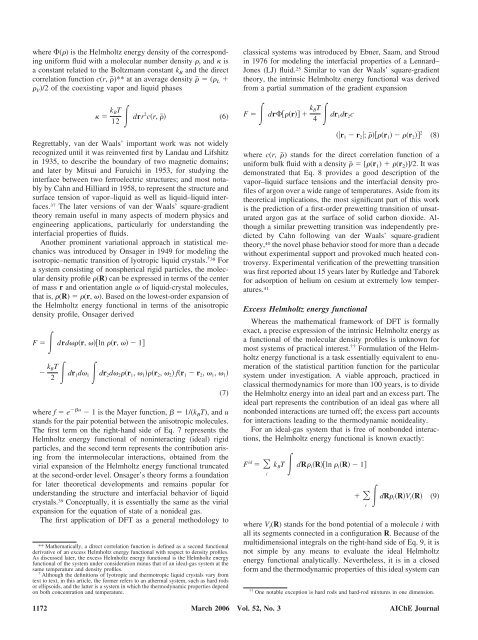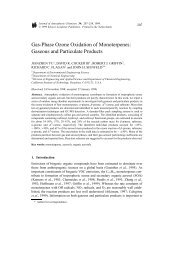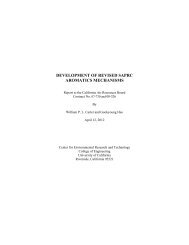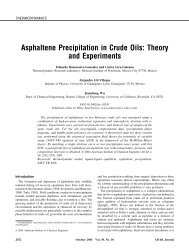Density functional theory for chemical engineering: From capillarity ...
Density functional theory for chemical engineering: From capillarity ...
Density functional theory for chemical engineering: From capillarity ...
Create successful ePaper yourself
Turn your PDF publications into a flip-book with our unique Google optimized e-Paper software.
where () is the Helmholtz energy density of the corresponding<br />
uni<strong>for</strong>m fluid with a molecular number density , and is<br />
a constant related to the Boltzmann constant k B and the direct<br />
correlation function c(r, )** at an average density ( L <br />
V )/2 of the coexisting vapor and liquid phases<br />
k BT<br />
12 drr2 cr, (6)<br />
Regrettably, van der Waals’ important work was not widely<br />
recognized until it was reinvented first by Landau and Lifshitz<br />
in 1935, to describe the boundary of two magnetic domains;<br />
and later by Mitsui and Furuichi in 1953, <strong>for</strong> studying the<br />
interface between two ferroelectric structures; and most notably<br />
by Cahn and Hilliard in 1958, to represent the structure and<br />
surface tension of vapor–liquid as well as liquid–liquid interfaces.<br />
37 The later versions of van der Waals’ square-gradient<br />
<strong>theory</strong> remain useful in many aspects of modern physics and<br />
<strong>engineering</strong> applications, particularly <strong>for</strong> understanding the<br />
interfacial properties of fluids.<br />
Another prominent variational approach in statistical mechanics<br />
was introduced by Onsager in 1949 <strong>for</strong> modeling the<br />
isotropic–nematic transition of lyotropic liquid crystals. † 38<br />
For<br />
a system consisting of nonspherical rigid particles, the molecular<br />
density profile (R) can be expressed in terms of the center<br />
of mass r and orientation angle of liquid-crystal molecules,<br />
that is, (R) (r, ). Based on the lowest-order expansion of<br />
the Helmholtz energy <strong>functional</strong> in terms of the anisotropic<br />
density profile, Onsager derived<br />
F drdr, ln r, 1<br />
k BT<br />
2 dr 1d 1 dr 2d 2 r 1 , 1 r 2 , 2 fr 1 r 2 , 1 , 1 <br />
where f e u 1 is the Mayer function, 1/(k B T), and u<br />
stands <strong>for</strong> the pair potential between the anisotropic molecules.<br />
The first term on the right-hand side of Eq. 7 represents the<br />
Helmholtz energy <strong>functional</strong> of noninteracting (ideal) rigid<br />
particles, and the second term represents the contribution arising<br />
from the intermolecular interactions, obtained from the<br />
virial expansion of the Helmholtz energy <strong>functional</strong> truncated<br />
at the second-order level. Onsager’s <strong>theory</strong> <strong>for</strong>ms a foundation<br />
<strong>for</strong> later theoretical developments and remains popular <strong>for</strong><br />
understanding the structure and interfacial behavior of liquid<br />
crystals. 39 Conceptually, it is essentially the same as the virial<br />
expansion <strong>for</strong> the equation of state of a nonideal gas.<br />
The first application of DFT as a general methodology to<br />
** Mathematically, a direct correlation function is defined as a second <strong>functional</strong><br />
derivative of an excess Helmholtz energy <strong>functional</strong> with respect to density profiles.<br />
As discussed later, the excess Helmholtz energy <strong>functional</strong> is the Helmholtz energy<br />
<strong>functional</strong> of the system under consideration minus that of an ideal-gas system at the<br />
same temperature and density profiles.<br />
† Although the definitions of lyotropic and thermotropic liquid crystals vary from<br />
text to text, in this article, the <strong>for</strong>mer refers to an athermal system, such as hard rods<br />
or ellipsoids, and the latter is a system in which the thermodynamic properties depend<br />
on both concentration and temperature.<br />
(7)<br />
classical systems was introduced by Ebner, Saam, and Stroud<br />
in 1976 <strong>for</strong> modeling the interfacial properties of a Lennard–<br />
Jones (LJ) fluid. 25 Similar to van der Waals’ square-gradient<br />
<strong>theory</strong>, the intrinsic Helmholtz energy <strong>functional</strong> was derived<br />
from a partial summation of the gradient expansion<br />
F drr k BT<br />
4 dr 1dr 2 c<br />
r 1 r 2 ; r 1 r 2 2 (8)<br />
where c(r, ) stands <strong>for</strong> the direct correlation function of a<br />
uni<strong>for</strong>m bulk fluid with a density [(r 1 ) (r 2 )]/2. It was<br />
demonstrated that Eq. 8 provides a good description of the<br />
vapor–liquid surface tensions and the interfacial density profiles<br />
of argon over a wide range of temperatures. Aside from its<br />
theoretical implications, the most significant part of this work<br />
is the prediction of a first-order prewetting transition of unsaturated<br />
argon gas at the surface of solid carbon dioxide. Although<br />
a similar prewetting transition was independently predicted<br />
by Cahn following van der Waals’ square-gradient<br />
<strong>theory</strong>, 40 the novel phase behavior stood <strong>for</strong> more than a decade<br />
without experimental support and provoked much heated controversy.<br />
Experimental verification of the prewetting transition<br />
was first reported about 15 years later by Rutledge and Taborek<br />
<strong>for</strong> adsorption of helium on cesium at extremely low temperatures.<br />
41<br />
Excess Helmholtz energy <strong>functional</strong><br />
Whereas the mathematical framework of DFT is <strong>for</strong>mally<br />
exact, a precise expression of the intrinsic Helmholtz energy as<br />
a <strong>functional</strong> of the molecular density profiles is unknown <strong>for</strong><br />
most systems of practical interest. †† Formulation of the Helmholtz<br />
energy <strong>functional</strong> is a task essentially equivalent to enumeration<br />
of the statistical partition function <strong>for</strong> the particular<br />
system under investigation. A viable approach, practiced in<br />
classical thermodynamics <strong>for</strong> more than 100 years, is to divide<br />
the Helmholtz energy into an ideal part and an excess part. The<br />
ideal part represents the contribution of an ideal gas where all<br />
nonbonded interactions are turned off; the excess part accounts<br />
<strong>for</strong> interactions leading to the thermodynamic nonideality.<br />
For an ideal-gas system that is free of nonbonded interactions,<br />
the Helmholtz energy <strong>functional</strong> is known exactly:<br />
F id <br />
i<br />
k B T dR iRln i R 1<br />
dR iRV i R (9)<br />
i<br />
where V i (R) stands <strong>for</strong> the bond potential of a molecule i with<br />
all its segments connected in a configuration R. Because of the<br />
multidimensional integrals on the right-hand side of Eq. 9, it is<br />
not simple by any means to evaluate the ideal Helmholtz<br />
energy <strong>functional</strong> analytically. Nevertheless, it is in a closed<br />
<strong>for</strong>m and the thermodynamic properties of this ideal system can<br />
†† One notable exception is hard rods and hard-rod mixtures in one dimension.<br />
1172 March 2006 Vol. 52, No. 3<br />
AIChE Journal
















